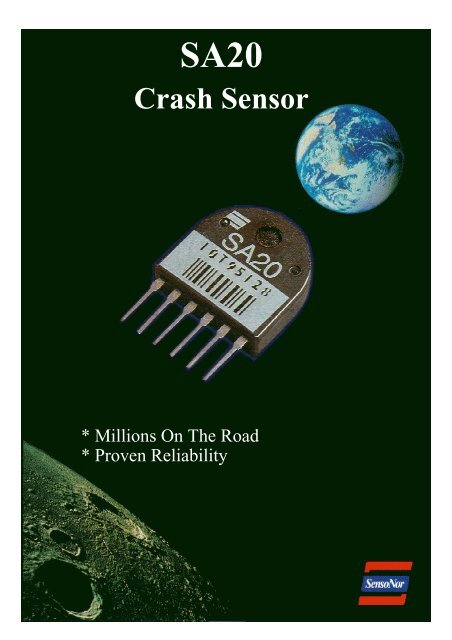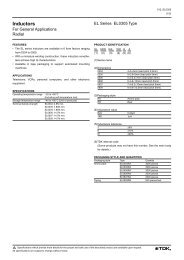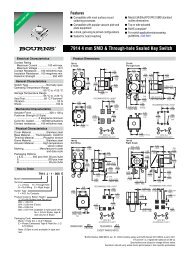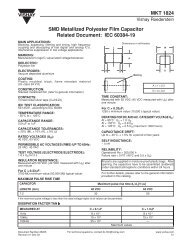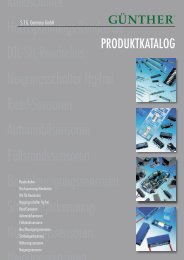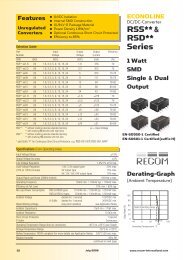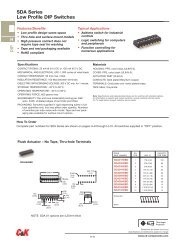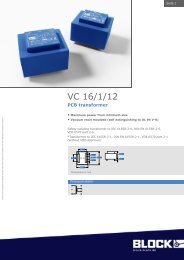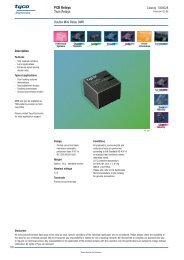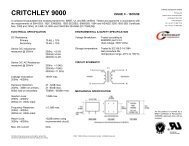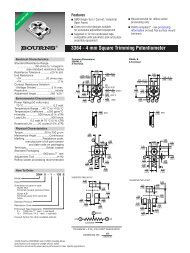SA20 Crash Sensor - SM Elektronik
SA20 Crash Sensor - SM Elektronik
SA20 Crash Sensor - SM Elektronik
Create successful ePaper yourself
Turn your PDF publications into a flip-book with our unique Google optimized e-Paper software.
<strong>SA20</strong><br />
<strong>Crash</strong> <strong>Sensor</strong><br />
* Millions On The Road<br />
* Proven Reliability
<strong>SA20</strong> <strong>Crash</strong> <strong>Sensor</strong><br />
General<br />
The SensoNor <strong>SA20</strong> <strong>Crash</strong><br />
<strong>Sensor</strong> is used by a number of<br />
air-bag system manufacturing<br />
companies and has made<br />
SensoNor the world’s no. l<br />
independent manufacturer of<br />
electronic crash sensors. The<br />
<strong>SA20</strong> represents SensoNor’s<br />
2. generation of crash sensors<br />
and is based on our experience<br />
since the mid 80ties as a crash<br />
sensor supplier.<br />
We commit 100% to our<br />
customers goals regarding costs Interior View<br />
and reliability. In practice this<br />
means that <strong>SA20</strong> is produced in a<br />
fully automated, high volume, element, it will be interfaced to a<br />
purpose built production line. range of well proven signal<br />
A carefully developed control conditioning interfacing circuits.<br />
plan is utilized to safeguard the<br />
production.<br />
An innovative concept of barcode<br />
marking the sensitivity onto the<br />
Since the production start <strong>SA20</strong> package of each individual sensor<br />
has been installed in millions of makes it easy to automatically<br />
systems. During these years <strong>SA20</strong> calibrate the sensor during<br />
has proven its exceptionally good system assembly at our customers.<br />
reliability. In addition, our work<br />
towards continuous improve- The excitation can be either<br />
ment has paid off in improved voltage or current. By current<br />
yields and improved effectiveness. excitation of a piezoresistive<br />
These facts in addition to the semiconductor strain gage a well<br />
technical approach in utilizing known "intrinsic" temperature<br />
well proven technology makes compensation can be achieved<br />
<strong>SA20</strong> the first choice in crash since the positive TCR of the<br />
sensing.<br />
bridge resistor compensate, for<br />
the negative TCS of the piezo<br />
Application<br />
resistivity.<br />
<strong>SA20</strong> is well suited for a range of<br />
system realizations. Due to a A diagnostic resistor is covering<br />
flexible production set-up a variety the rim of the elastic element.<br />
of pin configurations are possible; Monitoring the electrical<br />
Ranging from a DIL concept for consistency of this resistor makes<br />
sensitive direction normal to the it possible at all times to verify<br />
PCB, to a SIL concept meant for the mechanical consistency of<br />
sensitive direction horizontal to the device.<br />
the PCB, to special pin bending<br />
meant for surface mount. Since Concept<br />
the <strong>SA20</strong> includes a simple full <strong>SA20</strong> utilizes only a single<br />
bridge piezoresistive sensing (no sandwitch) very small<br />
Photo of Cantilever Chip<br />
(50x magnified)
<strong>SA20</strong> <strong>Crash</strong> <strong>Sensor</strong><br />
Electrical Schematic<br />
(2.5mm times 0.9mm) single process makes the sensing resistors and it will be extremely linear in<br />
crystal silicon element. This insensitive to surface effects like the specified range to +/-50g.<br />
element is directly forming a contamination.<br />
cantilever beam made possible Transportation Packaging<br />
by the combination of anisotropic Function <strong>SA20</strong> is shipped in ESD proof<br />
etching and diamond saw dicing. When exposed to an acceleration plastic magazines in customized<br />
field the inertia of the seismic mass shape and length according to the<br />
Onto the tip of the silicon beam will cause the silicon beam to mechanical pin configuration and<br />
a ceramic seismic mass is bend. The piezoresistors located customer specifications.<br />
bonded using a slit design. The near the surface of the beam will<br />
piezoresistive bridge consists of feel a high mechanical stress and<br />
two transversal and two long- they will change their value due to<br />
itudinal piezoresistors located in the piezoresistive effect in doped<br />
the maximum stress region. silicon. The change will be with<br />
opposite sign for the transversal<br />
The sensing element is housed in and the longitudinal resistors,<br />
a high reliability low cost welded giving a full bridge output. Due to<br />
PPS plastic housing. The inside the full bridge design, zero-point<br />
compartment is filled with shift as a function of temperature is<br />
instrument grade silicone oil for low. The output signal. is directly<br />
controlled dynamic damping. As ratiometric to the excitation signal.<br />
an integrated part of the housing<br />
a thinner plastic area acts as a The silicone oil viscosity is chosen<br />
diaphragm to equalize the inside to achieve critical damping at room<br />
pressure over the operational temperature.<br />
temperature range.<br />
Cross axis sensitivity is low due to<br />
Reliability is optimized by avoiding the ceramic mass which is symmemechanical<br />
overload stops which trically located as referred to the<br />
may cause internal fractures and bending plane.<br />
by the moisture preventing<br />
surrounding silicone oil. The output signal will have a<br />
In addition a “ buried”-resistor good linearity even above +/-500g<br />
Magazine Package
<strong>SA20</strong> <strong>Crash</strong> <strong>Sensor</strong> Specifications<br />
SensoNor asa<br />
Specifications may be subject to alteration without prior notice.<br />
P.O.Box 196. N-3192 Horten Norway, Tel: +47 33 03 50 00, Fax: +47 33 03 51 05<br />
E-mail sensonor@sensonor.no


